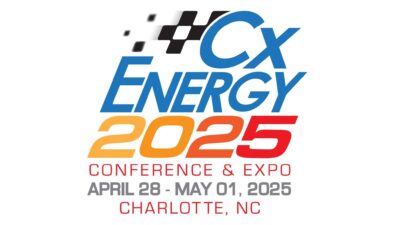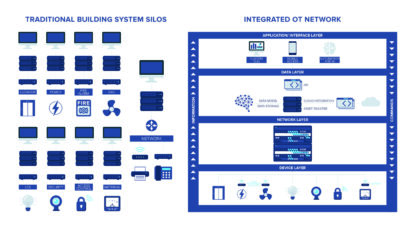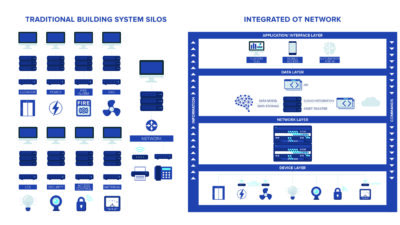The commissioning goal for any boiler is to achieve safe, reliable and efficient operation in accordance with the design intent and the owner's requirements. No two boiler brands are built or function alike. In order to be successful, the commissioning authority (CxA) must have a good understanding of the specific boiler being commissioned.
The commissioning goal for any boiler is to achieve safe, reliable and efficient operation in accordance with the design intent and the owner’s requirements. No two boiler brands are built or function alike. In order to be successful, the commissioning authority (CxA) must have a good understanding of the specific boiler being commissioned.
High-efficiency hydronic heating in today’s world generally consists of modular boilers at sizes up to 2 million BTUH. For purposes of this article, we’ll consider high-efficiency boilers to be non-condensing at 85% to 87%, and best-efficiency boilers to be condensing boilers that are more than 90% efficient.
Boilerplate
The CxA must understand the specific boiler manufacturer’s parameters. Aside from the basic boiler performance and rating, a CxA should know the minimum operating requirements, efficiency characteristics and internal controls. Most boilers, especially low-mass, non-condensing, copper-fin boilers, require a minimum flow rate, maximum temperature limit, minimum return water temperature and a range of gas pressure, all ensuring safe boiler operation. Efficiency can be affected by entering the return-water temperature and the burner control type, which could be on/off, two-stage or fully modulating. Knowing how the boiler achieves maximum efficiency will determine how to stage or modulate boilers and how to reset water temperature for maximum efficiency.
Field inspection and review
The CxA’s field inspection and installation review can prevent problems and ensure that the system is ready for functional testing. Combustion intake and exhaust vent locations should be checked. Are the vent and intake terminations well above the anticipated snow level? Or is there potential for ice-up on the combustion air intake due to nearby vent terminations?
Clearance around the boilers should be reviewed. Does the clearance comply with manufacturer requirements and codes? Is there adequate clearance for testing and routine service?
Provisions for water expansion should be reviewed. What is the make-up water regulator setting? What is the boiler-relief valve rating?
Other field review questions include: Does the boiler have an ASME stamp? Are the pressure-relief valves piped to a floor drain? Is the piping installed as designed? Are there code-compliant shutoff valves capable of isolating the boiler?
Prior to functional testing, the CxA should also review equipment startups, test reports and prefunctional checklists completed by the installing contractor.
Functional testing
Boiler sequencer panels or building-automation systems (BAS)—or both—control multiple modular boiler installations. Many engineers prefer the application-specific boiler sequencers, since they tend to take away programming guesswork and reduce human error. Regardless of how the boilers are controlled, if not programmed correctly, boiler sequencers and BAS can cause inefficient operation and operational problems. Good functional testing will ensure optimum efficiency and eliminate potential problems. Here are some things to check:
Internal boiler limits and controls. Each boiler’s internal operating controls should be checked for coordination with the master boiler sequencer. For example, if the boiler sequencer is staging boilers to maintain a setpoint of 180°F, but a boiler’s internal high limit set point is set at a value lower than 180°F, the boiler will shut down.
Outdoor air reset. High-efficiency boilers are typically most efficient when operating with the coldest return-water temperature possible. Optimizing the outdoor reset schedule for heating-water supply temperature will reduce energy consumption. The engineer should determine the lowest heating-water supply temperature that will satisfy the minimum boiler return-water temperature and still heat the building.
Minimum return water. Manufacturers of non-condensing boilers require a minimum return-water temperature to prevent corrosion and subsequent boiler failure. Some require a dedicated pump for each boiler with a bypass. The bypass is balanced to provide mixing of cool return water with the hot supply water to maintain the minimum temperature at the boiler inlet. The ability to maintain minimum return-water temperature can be tested by overriding the controls to supply the minimum supply-water temperature.
Boiler staging. Boilers should be staged to maintain a heating-water temperature set point. How boilers should be staged depends on the efficiency characteristics. A modulating condensing boiler may achieve highest efficiency at its lowest fire. In that case, boilers should modulate up and down together with as many boilers on as the load will allow. Other boilers may have near-constant combustion efficiency across their modulating range. For this, boilers can be staged on and off one after the other.
The CxA should pay close attention to the speed of response and delay between stages. For large systems with several on/off boilers, the response time may be slower due to the large volume of water and the location of the controlling temperature sensor. If the sequenced control loop is too fast, the controller may decide to bring on a second or third boiler to maintain the set point.
It is advantageous to test boiler systems in winter months when a large load can be created. Functional testing, ideally, should have all boilers modulate from a low load to a full load with all boilers firing. Witnessing this test in conditions as close to real as possible allows the CxA to see whether the combustion air and venting are adequate, the gas distribution feeding the boilers is adequate and the boiler system is capable of heating the building.
Component failure. Component failure should be included in any system test. If a boiler fails, an alarm should be generated and another boiler should start up. Similarly, a system-distribution pump failure should bring on a standby pump. If the boiler operation is interlocked with a water-flow switch, the flow switch and boiler shutdown should be tested.
Other sequencer operations. Functionality of other boiler sequencer capabilities should be fully tested. These may include:
-
First-on/last-off duty cycling
-
Unoccupied setback
-
Outside-air lockout
-
Vent-damper control
-
Integrated communication with the boilers and/or with the BAS
Chimney exhaust testing. Modular boiler plants can be individually vented or manifolded together into a common stack. Manifolded boilers typically require a chimney exhaust fan or in-line draft inducers.
Trending. Since the functional testing process constantly changes set points and turns boilers on and off, it’s difficult to see what the system will do under actual conditions. Setting up trends in the BAS or using data loggers allows the CxA to witness the system under actual loads in real time. Watching the system operate through changing outdoor air conditions or through a morning warm-up over the cycle of several days gives the best final indication of stable boiler system operation and the ability to keep the building warm.
Finally, commissioning cannot be complete without training. The CxA ensures that the owner is trained in the operation and maintenance of the system. This, along with owner involvement throughout the design and function testing, will help ensure a long and efficient life for the boiler system.



